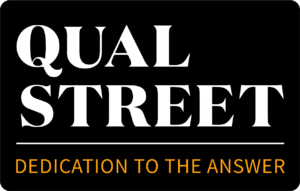Article by ICG members at Kath Rhodes and Claire Thomas at Qual Street.

For anyone undertaking a brand exploration: thinking about growth, innovation, developing a proposition or positioning … we would argue that they would be well-served think about a multi-method – layered research approach.
Why? Because people ‘think, feel and do’ brands in different ways and at different moments across their daily lives.
It’s why at Qual Street so many of our proposals end up being ‘layer cakes’.

We often have two or three layers to the cake, a shopping the brand layer, a using the brand layer, a layer that is about identity – me and the brand, a cultural layer …
This brings complexity to the design of our projects, and sometimes we know that complexity can feel overwhelming. If you have different consumer segments, participating in different methods – it can feel like a cake that’s cut into slices and layered. Which is certainly not straightforward.
But still, we’d like to argue in favour of ‘layered’ methodologies. And to suggest that by investing in a multi-method approach you should end up with a clear, uncomplicated outcome.
In order to grow, businesses need to understand how people’s head, heart and body all relate to the brand, and that means accepting complexity as an input – knowing that synthesis and clarity need to be the outcome of the project.
Multi-layered insight…and why it’s crucial…
Put your brand in this picture…
When we are buying, we come to the brand as a shopper. What drives our motivations at this point is ‘situated’. How we’re feeling in the moment [of purchase] affects our choices (are we up or down beat, energised or exhausted?) Qual Street’s year-long project (Year in the Life) following the lives of 9 women, highlighted for us the emotion cycle, how even in the pattern of an average week, people go through emotional (and physical) cycles that deeply affect how and what they buy.
As shoppers/ buyers people also have constraints – time, money, motivation. AND we are affected by behavioural influences: where a brand is sited, how well it tells its story at the point of choice, price and promotional influences.
So to understand a brand – we need, as part of the story, to know how it’s shopped … and to do this well we need to explore where it is purchased – the moment of purchase too. One layer to our cake.
People also have deep underlying drivers and needs that underpin their choices – mental connections, patterns and habits that are established outside of the shopping moment, as they use the brand. We have likely formed attachments, habits, behaviours that pre-determine the brands that we want and how we feel about them.
So we need to understand how the stories and experiences of a brand play out in life. How someone uses a brand, and how that use creates memories, and associations, which contribute to a person’s identity – the part a brand has to play in “the dream of the mind” (Will Storr).
We need to understand how the brand lives in people’s lives … ideally we want to see these brand experiences as they happen and understand their qualitative significance to a person. This is another layer to our cake. Again, if we can explore this ‘live’ – all the better. And so we can start to see the place diary apps, pre-tasks, in-home interviews, ethnography can all play in our exploration.
And beyond that there is the story the brand tells about itself through communication, advertising, PR, through the signs and symbols that it adopts and the part in plays in culture. Here we want a wider lens to explore how people, as part of the group, use the brand to navigate their way through the world. What part does it play in their role as a social being? People are inherently social– we relate to the groups we are in, yes as individuals, but always relative to other people. We have parts to play in the game of life – the mother, the lover, the hero, the helper, the helpless. Sometimes a sociological lens really helps to understand where a brand contributes to the human game, sometimes other cultural lenses – anthropology, semiotics should be applied.
And because we want to understand social influence, exploring the social mind – in ‘social mind groups’ in conversation can be really useful. We are layering again…
Layering helps us with a deeper, better understanding of what’s going on
There is another argument too for multi-methods.
Conversational methodologies also help us explore and dig into complexity. We often like to have ‘behavioural layers’ to our projects at Qual Street that are then topped off with conversation. (At-fixture work plus group conversations, for example, or diary work then zoom sessions to follow up). We completely accept that people don’t always know the ‘why’ behind what they do, so to understanding this we need to understand the ‘doing’. But that said we also see the value in conversation and methods that involve talking to people individually, in pairs and bigger group settings too.
Case study example…
We’re in the middle of a user-testing project at the moment. We’ve set up an on-line community where participants are trying out a prototype and reporting back. We have a really robust sample size and everyone’s done a great job in fulfilling their tasks. (In part because we like to brief everyone over Zoom these days before they start and get them ‘up’ for the project, and also because this project is more fun than average.) Everyone is acting as an ‘individual’ representative of their household in the ‘community’ part of this project. The only group contact they’ve had in this stage has been at the Zoom briefing at the start.
The responses we got from our on-line community were rich and detailed. On some level it felt like we’d learned what we needed to know. Because we are Qual Street, though, we also cherry-picked participants who’d given us interesting responses and reconvened them over Zoom to take part in on-line trios.
And these trios delivered significant and new insight.
Why? Well it’s the difference between text/ email and a chat. Text and emails are great for headlines and efficient, convenient ways to exchange information. But they fail when there are lots of interconnected ideas that need to be examined and then put back together again. So this comes back to brand/ layers. If the sensorial user experience is ‘x’, and we pull, stretch, examine that with participants, then perhaps the brand story would need to pull, stretch or change as a consequence. Conversational enquiry, is spontaneous, adaptable, and flexible. It took us further. And conversational dynamic, often does well in small groups, as participants compare and contrast their reactions with others. That said we like smaller groups so there isn’t too much ‘social brain’ dynamic going on. (Which is why we did trios).
In this project, we had to have the ‘trial’ part of the project. And the online community was perfect for that. We could ‘drop’ different tasks each day, and build up our understanding. But It turned out we really needed the conversational approaches too…to see how the brand story would come into play/ overlay.
Focus on detail going in to create a simple clear, picture coming out.
The danger of covering all the angles comes from reporting the complexity. Businesses don’t need to know what happened across the course of these different approaches.
Our job is NOT to report.
Our job, to keep the cake-making analogy going, is to mix up all the ingredients and bake in understanding. We need to communicate at the debrief stage clear ideas and insight that makes sense, so the client team know what to do next and why.
Busy businesses don’t have time to sift through detail, they need to know what the strategy is. Qual Street’s promise to clients is ‘dedication to the answer’. (It’s not we did this in a complicated way, here’s the complication for your to get your heads around).
Tech to help with sense-making
We love the part of our job which is about asking questions, but the bit we love more is sense-making. These days we’re using lots of tech to help us do our jobs better. We use Miro to help analyse our sessions – it’s a sandbox to play in and ‘dump’ ideas, it’s a place to build a story-telling structure…
We use Coloop AI to help us be more efficient (and the other AI that comes built into platforms like Qualzy, Fieldnotes) in our analysis and to find golden nuggets (film clips, quotes) that will help us tell the ‘story’ of the debrief better.
This technology is helping us handle the complexity we build into our research design both quickly and efficiently. The AI also brings a research assistant into play. We can ask Coloop to create summaries and basic insight. It delivers insta-analysis so we can be confident in the foundations that we are building our more nuanced and human understanding on.
Business is in a hurry – we can handle that
In the past, when we needed quicker insight we tended to plump for focus groups – lots of people, interviewed by a few researchers in a small amount of time. We know groups (on their own) are often quite a flawed method that do reveal social dynamics – how our ‘social minds’ operate, but aren’t reliable when it comes to brand behaviour.
Now we can use AI to our advantage to help work through the detail of our multi-method approaches (the right way to be doing brand projects) but much more quickly.
That said, you want a beautiful, delicious cake, you take time at all stages of the making…
Best results are always when time to reflect, question and review are built in to a project. It’s a luxury these days, but ultimately taking time delivers better insight.
The cake-makers…
Claire, Ambreen and I (Kath), we’ve all been doing qualitative research for around 30 years now… None of us can bear to do the actual maths – and we are qualitative researchers after all, but it’s decades of asking, listening, thinking, communicating.
If we are talking archetypes we’d be very happy if you visualised us as cooks in the kitchen, prepping, making, and then delivering delicious dishes.
However, you might have noticed that one of us, Ambreen, is all about the cake – she’s a cake-maker extraordinaire with her own cake-making business. So please do feel free to order up some wonderful, delicious qualitative insight from us. But if you live in the Brighton area, you never know – she might also bake you a cake too.
We love what we do, we want to work with you
Next project you have where you want to understand your brand, how people do, think, feel about it. We’d love to be part of that exploration.
https://www.qual-street.co.uk/
